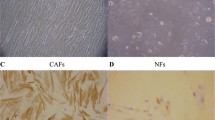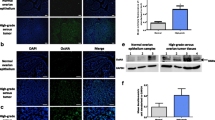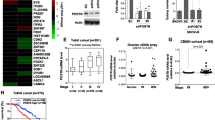Summary
This study was aimed to explore the role of stromal-derived factor 1 (SDF-1)/CXC chemokine receptor 4 (CXCR4) axis in mediating the metastasis of ovarian cancer cells through activation of extracellular signal-regulated kinase-1/2 (ERK-1/2) signaling pathway. A highly metastatic ovarian cancer cell line, SKOV3, was used in the study. Intracellular calcium mobilization was detected by using laser scanning confocal fluorescence microscopy. Western blotting was used to detect the phosphorylation of ERK1/2 in SDF-1α-treated SKOV3 cells. Adhesion capability and matrix metalloproteinase (MMP) activity of ovarian cancer cells after exposure to SDF-1α were measured by adhesion assay and gelatin zymography. The results showed that SDF-1α induced rapid intracellular calcium mobilization in SKOV3 cells, as well as the phosphorylation of ERK-1/2. The adhesion of ovarian cancer cells to fibronectin and collagen IV was increased after SDF-1α treatment. An inhibitor of ERK-1/2 signaling, PD98059, could antagonize such effects of SDF-1α. SDF-1α could also increase the secretion of active MMP-2 and MMP-9. It was concluded that the SDF-1/CXCR4 axis played a critical role in the metastasis of human ovarian cancer by increasing the adhesion capability of cancer cells and the activity of MMP-2 and MMP-9 via ERK1/2 signaling pathway.
Similar content being viewed by others
References
Balkwill F. The significance of cancer cell expression of the chemokine receptor CXCR4. Semin Cancer Biol, 2004,14(3):171–179
Grunewald M, Avraham I, Dor Y, et al. VEGF-induced adult neovascularization: recruitment, retention, and role of accessory cells. Cell, 2006,124(1):175–189
Katayama Y, Battista M, Kao WM, et al. Signals from the sympathetic nervous system regulate hematopoietic stem cell egress from bone marrow. Cell, 2006,124(2):407–421
Zou YR, Kottmann AH, Kuroda M, et al. Function of the chemokine receptor CXCR4 in haematopoiesis and in cerebellar development. Nature, 1998,393(6685):595–599
Begley LA, MacDonald JW, Day ML, et al. CXCL12 activates a robust transcriptional response in human prostate epithelial cells. J Biol Chem, 2007,282(37): 26767–2674
Kucia M, Jankowski K, Reca R, et al. CXCR4-SDF-1 signaling, locomotion, chemotaxis and adhesion. J Mol Histol, 2004,35(3):233–245
Muller A, Homey B, Soto H, et al. Involvement of chemokine receptors in breast cancer metastasis. Nature, 2001,410(6824):50–56
Orimo A, Gupta PB, Sgroi DC, et al. Stromal fibroblasts present in invasive human breast carcinomas promote tumor growth and angiogenesis through elevated SDF-1/CXCL12 secretion. Cell, 2005,121(3):335–348
Marchesi F, Monti P, Leone BE, et al. Increased survival, proliferation, and migration in metastatic human pancreatic tumor cells expressing functional CXCR4. Cancer Res, 2004,64(22):8420–8427
Scotton CJ, Wilson JL, Milliken D, et al. Epithelial cancer cell migration: a role for chemokine receptors? Cancer Res, 2001,61(13):4961–4965
Scotton CJ, Wilson JL, Scott K, et al. Multiple actions of the chemokine CXCL12 on epithelial tumor cells in human ovarian cancer. Cancer Res, 2002,62(20):5930–5938
Porcile C, Bajetto A, Barbieri F, et al. Stromal cell-derived factor-1alpha (SDF-1alpha/CXCL12) stimulates ovarian cancer cell growth through the EGF receptor transactivation. Exp Cell Res, 2005,08(2):241–253
Zlotnik A. Chemokines in neoplastic progression. Semin Cancer Biol, 2004,14(3):181–185
Chambers AF, Groom AC, MacDonald IC. Dissemination and growth of cancer cells in metastatic sites. Nat Rev Cancer, 2002,2(8):563–572
Christopherson KW II, Hangoc G, Mantel CR, et al. Modulation of hematopoietic stem cell homing and engraftment by CD26. Science, 2004,305(5686):1000–1003
Chung LW. Prostate carcinoma bone-stroma interaction and its biologic and therapeutic implications. Cancer, 2003, 97(3):772–778
Kryczek I, Lange A, Mottram P, et al. CXCL12 and vascular endothelial growth factor synergistically induce neoangiogenesis in human ovarian cancers. Cancer Res, 2005,65(2):465–472
Jiang YP, Wu XH, Shi B, et al. Expression of chemokine CXCL12 and its receptor CXCR4 in human epithelial ovarian cancer: an independent prognostic factor for tumor progression. Gynecol Oncol, 2006,103(1):226–233
Peled, A, Grabovsky V, Habler L, et al. The chemokine SDF-1 stimulates integrin-mediated arrest of CD34 (+) cells on vascular endothelium under shear flow. J Clin Invest, 1999,104(9):1199–1211
Murakami T, Maki W, Cardones AR, et al. Expression of CXC chemokine receptor-4 enhances the pulmonary metastatic potential of murine B16 melanoma cells. Cancer Res, 2002,62(24): 7328–7334
Brand S, Dambacher J, Beigel F, et al. CXCR4 and CXCL12 are inversely expressed in colorectal cancer cells and modulate cancer cell migration, invasion and MMP-9 activation. Exp Cell Res, 2005,310(1):117–130
Uchida D, Begum NM, Almofti A, et al. Possible role of stromal-cell-derived factor-1/CXCR4 signaling on lymph node metastasis of oral squamous cell carcinoma. Exp Cell Res, 2003,290(2):289–302
Yu X, Huang Y, Collin-Osdoby P, et al. Stromal cell-derived factor-1 (SDF-1) recruits osteoclast precursors by inducing chemotaxis, matrix metalloproteinase-9 (MMP-9) activity, and collagen transmigration. J Bone Miner Res, 2003,18(8):1404–1418
Author information
Authors and Affiliations
Additional information
This project was supported by a grant from Health Bureau of Hubei province (No. JX1A07).
Rights and permissions
About this article
Cite this article
Shen, X., Wang, S., Wang, H. et al. The role of SDF-1/CXCR4 axis in ovarian cancer metastasis. J. Huazhong Univ. Sci. Technol. [Med. Sci.] 29, 363–367 (2009). https://doi.org/10.1007/s11596-009-0320-0
Received:
Published:
Issue Date:
DOI: https://doi.org/10.1007/s11596-009-0320-0




